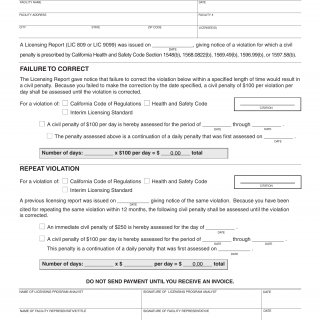Form LIC 421FC. Civil Penalty Assessment - Failure To Correct And Repeat Violations - California
Form LIC 421FC is used in California to assess civil penalties against licensed facilities or programs that have failed to correct violations or have repeated violations. The main purpose of this form is to document and enforce penalties for non-compliance with licensing requirements despite prior warnings or corrective actions.
The form consists of sections where the Department of Social Services (DSS) assesses the civil penalties against the facility or program. This may include details such as the facility's name, location, nature of the violations, applicable regulations, penalty amounts, and any additional information or documentation related to the case. The form may also provide spaces for the DSS representative's signature and date.
Important fields on this form include accurately documenting the repeated or uncorrected violations, ensuring adherence to the applicable regulations and guidelines, determining appropriate penalty amounts based on the severity of the violations and any prior history of non-compliance, and providing clear explanations or evidence to support the assessment. It is crucial for the DSS representative to thoroughly review the facility's history of violations, assess the effectiveness of previous corrective actions, and follow established procedures when completing the form to ensure fair enforcement of penalties.
Application Example: A licensed residential care facility in California repeatedly fails to maintain proper medication administration protocols despite prior warnings and corrective actions. Form LIC 421FC would be used by the DSS to assess civil penalties against the facility. By completing the form, the DSS addresses the repetitive nature of the violations, holds the facility accountable, and ensures compliance with licensing requirements.
Related Forms: There are no specific related forms mentioned for Form LIC 421FC. However, other documentation related to violation tracking, corrective action plans, and compliance monitoring may be utilized alongside this form to ensure comprehensive enforcement and oversight.

